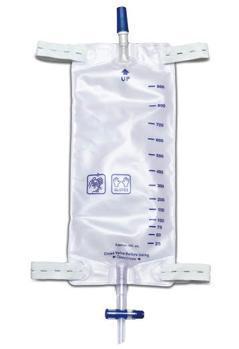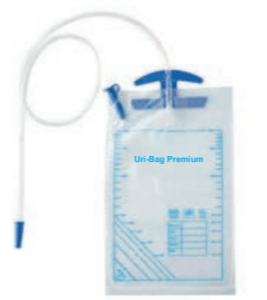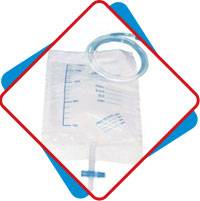Urine bags play a crucial role in managing urinary incontinence and providing a convenient solution for individuals with limited mobility or those recovering from surgery. Understanding the various types of urine bags available in the market is essential to ensure the right fit for specific needs. Whether it’s leg urine bags designed for optimum comfort or bedside urine bags that simplify collection for bedridden patients, we’ve got you covered. At Medzell, we believe in the power of knowledge. That’s why we will guide you through each aspect of urine bags, including the benefits of using leg urine bags for comfortable urine collection and how bedside urine bags can revolutionize the lives of patients with restricted movement.
Join us on this informative journey as we unravel the world of urine bags, enlightening you with valuable insights and empowering you to make informed decisions regarding your urinary management needs. Let’s embark on this adventure together, leaving no stone unturned in our quest for comprehensive knowledge about urine bags.
Different Types of Urine Bags
Urine bags come in various types to cater to different needs and situations.
- Standard urine bag: They are designed to be attached to a catheter and collect urine efficiently. Standard urine bags are available in different sizes to accommodate varying urine volumes.
- Leg urine bag: Leg urine bags are specifically designed for individuals who are mobile and need a urine collection solution that offers freedom of movement. These bags are discreetly attached to the leg and can be easily concealed under clothing. The straps and secure attachment ensure stability and prevent leakage.
- Bedside urine bag: Bedside urine bags are designed for patients who are bedridden or have limited mobility. They are large and hence can be easily placed on the side of the bed. Bedside urine bags often have a longer tubing length to allow for easy drainage.
- Urinary drainage bag: These bags are used for long-term urine collection and are typically attached to indwelling urinary catheters. They come in different capacities to accommodate varying drainage needs. Urinary drainage bags are designed for comfort and safety, with features such as anti-reflux valves to prevent backflow.
- Leg bag straps: Leg bag straps are accessories used to secure leg urine bags in place. They provide additional support and ensure that the urine bag stays securely attached to the leg without causing discomfort or skin irritation.
Advantages of Leg Urine Bags
Leg urine bags offer several advantages that make them a preferred choice for individuals seeking convenient and comfortable urine collection.
- Mobility: Leg urine bags allow for greater mobility and independence. They are discreetly worn on the leg, allowing users to move freely without the need for bulky equipment.
- Discreetness: Leg urine bags are designed to be discreet and inconspicuous. They can be easily concealed under clothing, providing users with privacy and a sense of normalcy.
- Comfort: User comfort is a key consideration in the design of leg urine bags. They are lightweight, flexible, and made from soft materials to minimize discomfort and skin irritation.
- Secure attachment: Leg urine bags come with adjustable straps that ensure a secure and snug fit. This prevents the bag from shifting or slipping during movement, providing peace of mind to the user.
- Easy drainage: Leg urine bags are equipped with convenient drainage mechanisms, such as twist valves or flip-flow valves, which allow for easy and hygienic urine drainage without the need for removing the bag.
Exploring Bedside Urine Bag
Bedside urine bags are a crucial component of urinary management for individuals who are bedridden or have limited mobility. These specialized urine bags offer convenience, comfort, and ease of use. With their unique features and design, bedside urine bags simplify urine collection and promote patient well-being. When selecting a bedside urine bag, consider factors such as capacity, material, and secure attachment mechanisms. The capacity should align with the patient’s needs to minimize the frequency of bag changes.
To use a bedside urine bag effectively, follow these step-by-step instructions:
- Start by ensuring adequate hand hygiene and donning disposable gloves.
- Position the patient comfortably on their back or side, ensuring easy access to the genital area.
- Clean the genital area with mild soap and warm water, using gentle, downward strokes.
- Connect the drainage tubing to the urine bag, ensuring a secure fit.
- Open the bag’s drainage port and allow urine to flow freely.
- Position the bag below the patient’s bladder, ensuring it hangs freely without any kinks or tension on the tubing.
- Monitor the urine flow and ensure the bag remains securely attached throughout.
Proper Techniques for Emptying Urine Bag
Emptying urine bags properly is essential for maintaining hygiene and preventing infections. Follow these guidelines for safe and hygienic emptying of urine bags:
- Put on disposable gloves and gather the necessary supplies, including a clean container, disinfectant wipes, and a designated area for emptying.
- Position the container below the drainage port of the urine bag, ensuring a secure fit to prevent spillage.
- Carefully open the drainage port, allowing urine to flow into the container.
- Avoid any contact between the drainage port and the container to prevent cross-contamination.
- Once the bag is empty, close the drainage port tightly to prevent any leakage or odors.
- Dispose of the urine in a designated sanitary facility or as per healthcare facility guidelines.
- Clean the container properly using soap and warm water.
- Wash your hands thoroughly with soap and water after emptying the urine bag.
Best Practices for Cleaning Urine Bag
Maintaining cleanliness and proper hygiene of urine bags is vital to prevent infections and ensure their longevity. By following these best practices for cleaning urine bags, you can ensure their effectiveness and durability:
- Always wear disposable gloves before handling urine bags to minimize the risk of contamination.
- Start by emptying the urine bag using proper techniques as mentioned earlier.
- Fill the basin with clean warm water and a mild soap.
- Disconnect the drainage tubing from the urine bag, following the manufacturer’s instructions.
- Submerge the urine bag and drainage tubing in the soapy water solution.
- Gently agitate the bag and tubing, ensuring that the soapy water reaches all surfaces.
- Rinse the bag and tubing thoroughly with clean, running water to remove all soap residue.
- Allow the bag and tubing to air dry completely before reassembling and storing.
- Store the cleaned and dried urine bag in a clean, dry, and designated storage area.
- Clean any surfaces that may have come in contact with the urine bag or its contents.
Dealing with Urine Bag Leaks
Urine bag leaks can be inconvenient and uncomfortable for individuals relying on them for urinary management. However, there are strategies to minimize and address urine bag leaks effectively. Here are some tips for dealing with urine bag leaks:
- Ensure a proper and secure connection between the drainage tubing and the urine bag. Check for any loose or damaged connections and replace them if necessary.
- Position the urine bag correctly, ensuring it hangs freely without any kinks or tension on the tubing. This allows for proper urine flow and reduces the risk of leaks.
- Regularly inspect the drainage tubing for any cracks, holes, or blockages. Replace damaged tubing immediately to prevent leaks.
- Empty the urine bag before it reaches full capacity. Overfilling can put pressure on the bag and tubing, increasing the risk of leaks.
- Consider using additional securing methods such as leg straps or special adhesive attachments to keep the urine bag in place and minimize movement.
- If a leak does occur, carefully clean and dry the affected area before applying a clean, absorbent pad or garment to contain the leakage.
- Contact a healthcare professional or the manufacturer of the urine bag for further assistance if the leaks persist or become recurrent.
Remember, addressing urine bag leaks promptly and effectively is essential for the comfort and well-being of individuals relying on them for urinary management.
Relieving Discomfort from Urine Bag
While urine bags serve an important purpose in urine management, they can sometimes cause discomfort. Here are some ways to alleviate discomfort associated with urine bags:
- Proper Positioning: Ensure the urine bag is positioned correctly to avoid unnecessary tension or pulling on the tubing. Adjust the straps or fastenings to achieve a comfortable fit.
- Skin Care: Pay attention to the skin around the urine bag and the insertion site. Keep the area clean, dry, and moisturized to prevent skin irritation or pressure sores.
- Size and Fit: Opt for urine bags that are the right size for your needs. Too small or too large bags can cause discomfort. Consult with your healthcare provider to determine the appropriate size for optimal comfort.
- Use Cushioning: Consider using foam or gel pads to provide additional cushioning between the urine bag and your body. This can help reduce pressure and discomfort.
- Seek Professional Assistance: If you experience persistent discomfort or pain related to urine bag usage, consult your healthcare provider. They can evaluate the situation, identify any underlying issues, and provide tailored solutions.
Eliminating Odor in Urine Bags
Odor can be a common concern when it comes to urine bags, but with the right strategies, you can effectively eliminate unpleasant smells. Here are some tips to keep your urine bags odor-free:
- Cleanliness is Key: Regularly clean the urine bag and tubing with mild soap and warm water. Ensure thorough rinsing to remove any residue that may contribute to odor.
- Proper Ventilation: Ensure proper ventilation of the urine bag by keeping the drainage tube unobstructed. This helps prevent the buildup of odor-causing bacteria.
- Odour Neutralizers: Consider using odour-neutralizing products specifically designed for urine bags. These products help eliminate odors and provide a fresh scent.
- Empty the Bag Regularly: Regularly emptying the urine bag prevents the accumulation of urine, which can lead to odor. Follow the recommended schedule for emptying the bag based on your specific needs.
- Store Properly: When not in use, store the urine bag in a clean and dry place. Avoid exposing it to extreme temperatures or direct sunlight, as these can contribute to odor development.
Remember, if you notice persistent or strong odors despite following these measures, consult your healthcare provider for further guidance. They can assess if any underlying issues are contributing to the odor and provide appropriate recommendations.
Urine Bags From Leading Indian Manufacturers
Urine Leg Bags
 Urine Leg Bags, manufactured by Ribbel International Limited, are specially designed for individuals dealing with incontinence during daytime use. These leg bags offer convenience and discretion, allowing users to comfortably and securely collect urine while on the move. The leg bags feature a T-Trap drain port that accepts a silicone tube, making it easy to connect and disconnect. They are equipped with a non-return valve that prevents urine from flowing backward, ensuring proper drainage and preventing discomfort. The soft nonwoven fabric at the back of the bag provides added comfort, while the clinical-grade PVC sheets ensure durability and reliability. The graded design of the bag allows for easy and accurate measurement of urine output.
Urine Leg Bags, manufactured by Ribbel International Limited, are specially designed for individuals dealing with incontinence during daytime use. These leg bags offer convenience and discretion, allowing users to comfortably and securely collect urine while on the move. The leg bags feature a T-Trap drain port that accepts a silicone tube, making it easy to connect and disconnect. They are equipped with a non-return valve that prevents urine from flowing backward, ensuring proper drainage and preventing discomfort. The soft nonwoven fabric at the back of the bag provides added comfort, while the clinical-grade PVC sheets ensure durability and reliability. The graded design of the bag allows for easy and accurate measurement of urine output.
Urine Collection Bag For Paediatric
 The Urine Collection Bag For Paediatric, manufactured by DR. AM’S HEALTHCARE, is designed specifically for short-term urine collection from neonates. This E.O. sterile bag provides a safe and hygienic solution for collecting urine samples from infants. The bag is equipped with a hypoallergenic self-adhesive for improved grip and to avoid itchiness, ensuring the comfort of the baby’s delicate skin. The adhesive also allows for easy removal from the baby’s skin without causing any discomfort. In addition to urine collection, stool urine containers are also available, providing a comprehensive solution for pediatric urine collection needs.
The Urine Collection Bag For Paediatric, manufactured by DR. AM’S HEALTHCARE, is designed specifically for short-term urine collection from neonates. This E.O. sterile bag provides a safe and hygienic solution for collecting urine samples from infants. The bag is equipped with a hypoallergenic self-adhesive for improved grip and to avoid itchiness, ensuring the comfort of the baby’s delicate skin. The adhesive also allows for easy removal from the baby’s skin without causing any discomfort. In addition to urine collection, stool urine containers are also available, providing a comprehensive solution for pediatric urine collection needs.
Urine Collection Bag
The Urine Collection Bag is a reliable and leak-proof product designed for urine collection. The bag, manufactured by Nishi Medcare, features a dual seal that ensures leak-proof, providing peace of mind for both patients and healthcare professionals. The bag is designed with a legible chart printed on it, allowing for easy and accurate measurement of urine output. Each SURGIPAL reserve urine collecting bag undergoes thorough efficiency testing before being released onto the market, ensuring its quality and performance.
Uri-Bag Premium
 Uri-Bag Premium, manufactured by Aurus MedTech Pvt. Ltd., is a top-quality urine bag designed to meet the specific needs of healthcare providers and patients requiring urine collection for diagnostic and treatment purposes. This high-quality product offers a range of features to optimize urine collection and ensure user comfort. With a generous capacity of 2000 ml, Uri-Bag Premium is ideal for patients who need to collect a significant amount of urine, reducing the need for frequent bag changes. Made of medical-grade, non-toxic, bio-compatible PVC material, Uri-Bag Premium prioritizes patient safety and well-being. The bag is equipped with a top outlet and hanger, allowing for easy attachment and use.
Uri-Bag Premium, manufactured by Aurus MedTech Pvt. Ltd., is a top-quality urine bag designed to meet the specific needs of healthcare providers and patients requiring urine collection for diagnostic and treatment purposes. This high-quality product offers a range of features to optimize urine collection and ensure user comfort. With a generous capacity of 2000 ml, Uri-Bag Premium is ideal for patients who need to collect a significant amount of urine, reducing the need for frequent bag changes. Made of medical-grade, non-toxic, bio-compatible PVC material, Uri-Bag Premium prioritizes patient safety and well-being. The bag is equipped with a top outlet and hanger, allowing for easy attachment and use.
Conclusion
Urine bags play a crucial role in urine collection and management for various medical situations. By understanding the different types of urine bags available, such as leg urine bags, bedside urine bags, and condom catheter bags, individuals can make informed choices based on their specific needs. Emptying and cleaning urine bags require careful attention to prevent issues such as leaks and odor. By adopting proper techniques and best practices, individuals can maintain the integrity of urine bags, ensuring durability and infection prevention. It’s important to address common challenges associated with urine bags, such as leaks and discomfort. By implementing troubleshooting strategies and exploring ways to eliminate odor and alleviate discomfort, users can enhance their overall experience.
In the world of urine bags, knowledge empowers individuals to take control of their urinary health and improve their quality of life. Embrace the possibilities and make informed choices for a better urine management experience.



